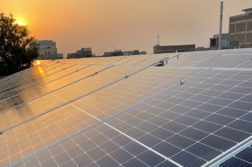What’s covered under the Scheme?
The big three: power stations are IN, transport is IN, coal mining is IN.
All Kyoto greenhouse gases will be included, but not the fancy new ones — like those involved in flatscreen TV production, for example.
The emissions threshold which must be exceeded for businesses to require permits is 25,000 tonnes. In other words, it’s pretty high and will only touch the biggest polluters, around 1000 companies. This simplifies the paperwork as there will be less people to audit.
Those who manage the technical wizardry of Carbon Capture and Storage (CCS) can make deductions from their total emissions.
And what’s not covered?
Biofuels and biomass are OUT.
Agriculture is OUT for now but will be IN by 2015.
Deforestation is OUT – but reforestation is included as an eligible deduction.
So transport is in. What about fuel?
The scheme includes a fuel excise trade-off "adjustment". Here’s what it says in the Summary Report. "The Government has committed to cut fuel taxes on a cent for cent basis to offset the initial price impact on fuel associated with the introduction of the Carbon Pollution Reduction Scheme. The Government will periodically assess the adequacy of this measure for three years and adjust this offset accordingly. At the end of the three year period the Government will review this adjustment mechanism."
How will all this affect households?
All money raised will be returned to households and business via tax breaks. Low- and middle-income households will be assisted through tax cuts and family payments and government benefits will be increased above inflation.
Is there any assistance for polluting industries that export?
Yes. The so-called "emissions-intensive trade-exposed" industries like aluminium smelting, concrete and steel making will get assistance in the form of free carbon permits.
20 per cent of permits will be given away free to exporters but the number of permits given away will decline over time. After 2020, if the rest of the world joins in, these free permits will be phased out.
And what’s the deal for coal-fired power stations?
Coal-fired power stations will get a one-off, once-only cash payment. Brown coal-fired power stations will get more assistance than black coal plants, reflecting the higher number of carbon permits brown coal plants will need. Only power stations built or committed to being built by mid-2007 will qualify. Assistance level will vary according to number of jobs at stake and rural location. And whether it’s a marginal seat: the "Latrobe Valley" effect…
Do any other industries get a hand?
Fishing and agriculture get a rebate and so do truckers and heavy transport users.
How will the Emissions Trading Scheme operate?
The Emissions Trading Scheme’s currency is the permit, or Australian Emissions Unit. One permit equals one tonne of CO2 or its equivalent. Permits are eternal and bankable — companies can bank as many as they buy for as long as they like. They can be bought and sold internationally. Some borrowing of future permits is also allowed — up to 5 per cent of the next year’s quota. A four year price cap has been set on the permits from 2010/11 to 2014/15.
Auctions for permits will be held quarterly, for permit vintages of the current years and one, two and three years in advance.
What are the emissions targets?
They haven’t been settled yet. By the end of 2008 the Government will announce a 2020 target "range" including an upper and lower amount of emissions, to give the markets an idea of future supply.
The Government will set a rolling cap on emissions five years in advance, to be updated every year. If the Government signs up to a new Kyoto-style international emissions protocol, it will extend the five year guidance to the lifetime of that commitment.
Who holds the stick? How will reporting and compliance work?
The scheme establishes national bureaucracy to be called National Greenhouse and Energy Reporting System (NGERS — don’t say it too quickly). Other related Federal Government schemes — like fuel excise — will also be brought into the fold.
Liable entities are required to monitor their emissions under an approved set of methodologies, and report annually to NGERS. The accounting entity is the corporation or individual in operational control of the pollution.
Companies have to report to NGERS before they can surrender their permits. Really large emitters (more than 125,000 tonnes) will need their emissions audited.
What new tax and accounting issues are raised by the Carbon Pollution Reduction Scheme?
Lots. A new income tax law will need to be written to cover permit deductions.
Permits will be tax deductible only when bought, sold or surrendered. Tax deductibility can be banked but not booked in advance. Revenue from permit sales, on the other hand, is taxable income. Free permits and industry assistance given to polluting companies will also be treated as taxable income. GST will apply.
How will State/Federal issues be dealt with?
COAG will work with State Governments to abandon their local renewable energy targets and schemes in favour of the national scheme.
Read the Green Paper and assorted Fact Sheets here.
Donate To New Matilda
New Matilda is a small, independent media outlet. We survive through reader contributions, and never losing a lawsuit. If you got something from this article, giving something back helps us to continue speaking truth to power. Every little bit counts.



